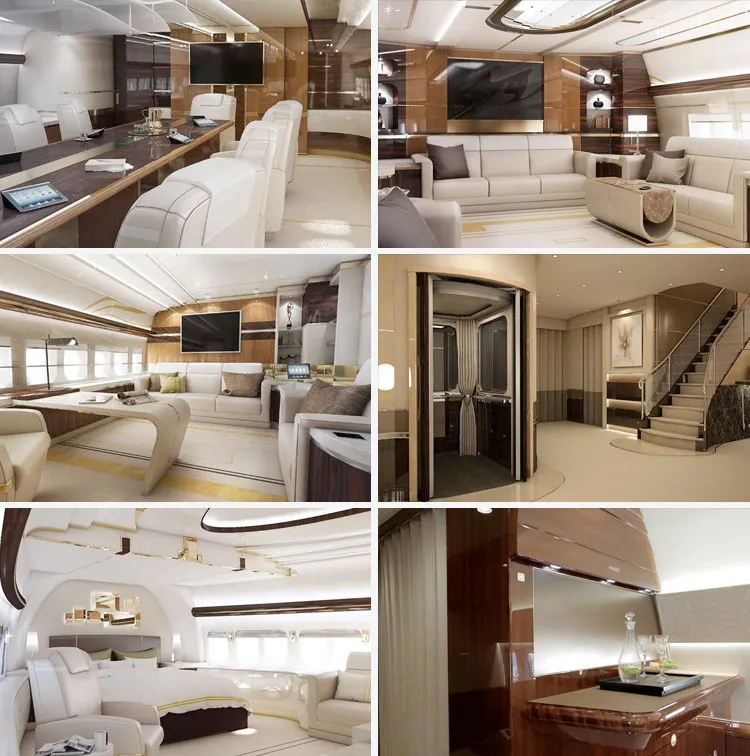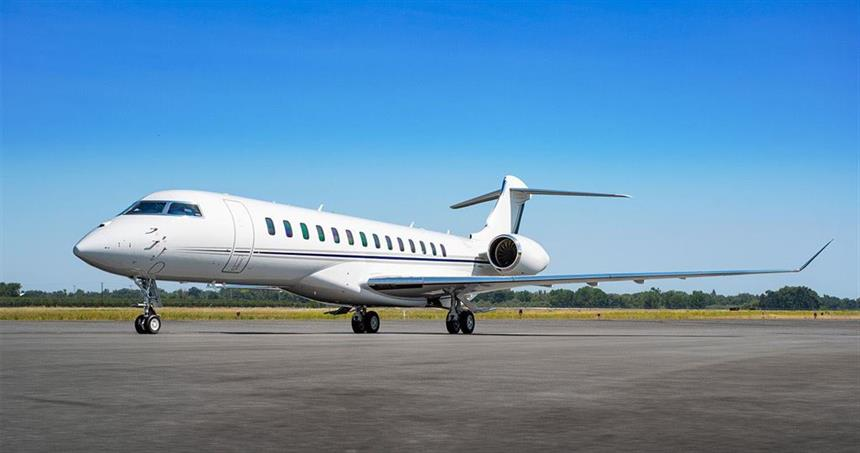
The largest private jet in the world is the Boeing 747-8 VIP, spanning 224 feet with over 4,700 sq ft of space. It costs over $400 million and includes dining rooms, bedrooms, and lounges.
Other top contenders like the Global 7500 offer luxury, speed, and better airport access.
In private aviation, size isn’t just about flash, it’s about what’s possible.
The world’s largest private jets aren’t just larger cabins; they represent global reach, advanced engineering, and an entirely different category of flight experience. But while these aircraft grab headlines with lounge-sized interiors and multi-million-dollar customization, owning and operating one isn’t always what it seems.
In this guide, we break down which jet truly holds the title for largest, how much it costs, what you can expect inside, and how it stacks up to other aircraft that may offer more usability, efficiency, and value.
Whether you’re shopping, researching, or just curious, this is your cockpit view into the sky’s most commanding rides.
The Absolute Largest: Boeing 747-8 VIP
The Boeing 747-8 VIP holds the undisputed title as the largest private jet in the world. With a wingspan of 224 feet 7 inches and over 4,700 square feet of interior space, it’s more airborne estate than aircraft. Originally designed for commercial use, this jet is repurposed by ultra-wealthy clients into private palaces in the sky.
Its 8,000+ nautical mile range enables global, nonstop travel, making it capable of flying from Los Angeles to Sydney without refueling. The passenger capacity? Entirely dependent on how it’s outfitted. Some fit 50+ passengers; others prioritize expansive suites over headcount.
Interior Features & Layout
What sets the 747-8 VIP apart isn’t just its scale, but how that space is used. These jets can include:
- Multiple master suites with king-size beds
- Full-scale dining rooms and private cinemas
- Dedicated boardrooms, spa-style bathrooms, even car garages on board

Photo: Inside Boeing 747-8.
Each aircraft is custom-built from scratch, with options ranging from minimalist Scandinavian aesthetics to Versailles-level opulence. Billionaire Joseph Lau’s personal 747-8 includes gold-plated fixtures and a wine cellar. Heads of state often install defense tech, secure communications, and bulletproof zones.
Cost & Ownership
The baseline aircraft starts at $367 million, but once outfitting begins, total costs can exceed $450 million. Add another $30 million+ per year in operating expenses, covering full-time flight crews, insurance, global hangar space, fuel, and routine maintenance.
Jets this large face another limitation: airport access. They can’t land just anywhere, which severely restricts spontaneity and adds ground transport time from smaller city centers.
The Largest Business Jet: Bombardier Global 7500
Size and Engineering
If the 747-8 is a flying palace, the Bombardier Global 7500 is a high-performance penthouse suite. At 2,786 cubic feet of cabin space, it is the largest purpose-built business jet on the market today. Measuring 54 feet 5 inches in length with a wingspan of 104 feet, it can cruise at Mach 0.90 and fly up to 7,700 nautical miles nonstop.
That range makes it possible to fly New York to Hong Kong without a fuel stop, more efficiently than a commercial airline.
Interior Design
The interior is divided into four distinct living zones: a club suite, conference area, entertainment lounge, and a private master bedroom. There’s also a fully equipped kitchen and a crew rest area.
Bombardier’s proprietary Nuage seating allows deep reclining and ergonomic support, ideal for long-haul rest. Air quality is a standout too: the Global 7500 uses a HEPA-based Pũr Air system, filtering 99.99% of airborne particles and maintaining one of the lowest cabin altitudes in the industry.
Cost Breakdown
The Global 7500 is priced between $75 million and $85 million, depending on customization. While that’s a fraction of the 747-8 VIP’s cost, its operating costs still run about $16,000 per hour, not including landing fees, catering, or crew wait time.
Still, its airport accessibility is superior. Unlike converted airliners, it can land at many smaller regional airports, making it far more practical for real-world business and leisure travel.
Top 5 Largest Private Jets (Quick Comparison)
| Jet | Cabin Volume | Max Range | Price | Passenger Cap |
| Boeing 747-8 VIP | 4,700+ sq ft | 8,000 nm | $400M+ | 50+ |
| Bombardier Global 7500 | 2,786 cu ft | 7,700 nm | $85M | 19 |
| Dassault Falcon 10X | 2,780 cu ft | 7,500 nm | $75M | 19 |
| Gulfstream G700 | 2,603 cu ft | 7,500 nm | $75M | 19 |
| Gulfstream G650ER | 2,421 cu ft | 7,500 nm | $70M | 19 |
These jets differ not just in size, but in range, functionality, and real-world usability, something first-time buyers often overlook.
What Makes These Jets So Expensive?
The ultra-premium tier of private aviation delivers more than just square footage. The Bombardier Global 8000, for instance, broke the speed of sound in flight testing, an unprecedented feat for a business jet.
The Falcon 10X boasts next-gen ozone air filtration and SAF compatibility, appealing to environmentally conscious buyers. Meanwhile, cabin tech includes:
- Fully programmable LED environments
- 4K entertainment systems
- Satellite streaming and surround sound
- Advanced flight management with AI integration
Branding also plays a role. These aircraft often serve as status symbols, wrapped in design collaborations with fashion houses or automotive marques.
Behind-the-Scenes Costs
Every square foot of personalization can triple the original cost. Interior outfitting, especially when adding rare materials, secure networking, and unique spatial layouts, often exceeds $100 million.
Operational costs go beyond fuel. Scheduling, crew readiness, hanger logistics, and maintenance turnarounds all require a highly coordinated operation. For owners without full-time aviation staff, this adds another layer of complication, and cost.
Real-World Questions: Are These Jets Even Practical?
While the Boeing 747-8 VIP and Global 7500 showcase engineering brilliance, their size limits flexibility. Jets like the 747-8 cannot land at most regional or executive airports due to runway length and infrastructure constraints. Even the Global 7500, with its more compact footprint, faces occasional limitations in high-altitude or short-field scenarios.
For many operators, practicality is the sticking point. Aircraft that impress on paper may fall short in daily utility. There’s a growing acknowledgment among seasoned buyers and operators: ultra-large jets can cross oceans, but they often require long ground transfers to reach final destinations.
The tension between practicality and presentation remains. Some clients view ultra-jets as business tools. Others treat them as airborne statements of success. But both must wrestle with the same realities of access, logistics, and recurring costs.
Who Actually Uses Them?
Ultra-large private jets are primarily owned by billionaires, foreign dignitaries, and royalty. Figures like Joseph Lau and heads of state often customize these aircraft for privacy, diplomatic use, or corporate command centers in the sky. Yet, for all their grandeur, these aircraft invite public attention. Their movements are frequently tracked, and their interiors documented in luxury media features.
Privacy isn’t guaranteed, especially when the aircraft itself becomes a headline.
Are They Worth It?
With operating costs that can exceed $16,000 per hour, jets like the Global 7500 are rarely owned outright by anyone other than billionaires or multinational corporations. This cost excludes ramp fees, repositioning, or crew standby hours.
Buyers increasingly weigh efficiency versus extravagance. The 747-8 VIP might impress guests, but it’s the Challenger 300 or Gulfstream G650 that most frequent flyers prefer for consistent, reliable travel. The difference lies not in how much you can spend, but how often you can actually use what you’ve bought.
What If You Don’t Need the Biggest?
For professionals and families who fly private often, but don’t need to host 50 guests at 40,000 feet, there’s a smarter path. FlyUSA’s Bombardier Challenger 300 offers:
- A 3,100 nautical mile range
- A cabin designed for quiet, high-comfort travel
- Access to smaller airports and FBOs most ultra-jets can’t reach
It’s also charter-ready, meaning you can fly when you need to, without the financial weight of ownership.
Operational Efficiency
FlyUSA operates differently. Our team isn’t a broker, we own and manage our fleet, maintenance operations, and airport ground services. That means:
- Faster turnaround times
- Tighter safety controls
- Predictable pricing
While a 747-8 might catch eyes, it’s aircraft like the Challenger 300 that keep business moving. It’s a tool, not a trophy, and for clients who value agility, consistency, and reliability, that’s exactly what matters.
Big Isn’t Always Better
If you’re looking for the biggest private jet in the world, the answer is clear: the Boeing 747-8 VIP. No other private aircraft offers more space or stage presence. But if your goal is consistent, efficient travel, not extravagant statements, the Bombardier Global 7500 may be the better machine. And for those flying frequently or with business constraints, the Challenger 300 offers the best blend of performance and practicality.

Photo: Bombardier Global 7500.
Luxury should serve your lifestyle, not limit it. And in aviation, usability often beats square footage.
Ready for Something More Usable Than “The Largest”?

Chasing the largest private jet in the world sounds thrilling, until reality hits. Limited airport access, jaw-dropping operating costs, and logistical complexity turn a dream ride into a full-time management project. That’s why many high-frequency flyers are shifting focus, from bragging rights to real-world performance.
At FlyUSA, we offer the kind of aviation solutions that are built for use, not just show:
- Charter the right jet for your mission, from a Challenger 300 to a Gulfstream G650, we’ll match you with a fleet we control, not just broker.
- Fly on your terms, with full operational oversight, in-house maintenance, and 24/7 expert advisors.
- Save time and stress, thanks to aircraft that access more airports, require less runway, and are ready when you are.
What Life Looks Like When You Fly with FlyUSA
Your travel becomes seamless. You make one call, and the aircraft is ready. There’s no guessing who’s managing the plane, no waiting on maintenance vendors, no shuffling between brokers. You land closer to your destination, spend less time in terminals, and gain back hours of your life. All while flying in an aircraft you trust, because we operate it ourselves.
Start flying smarter 👉 Contact FlyUSA now and experience aviation with total control, clarity, and confidence.
About FlyUSA, Inc.:
FlyUSA, Inc. provides seamless, end-to-end private aviation solutions to clients across the United States. Founded by pilots and built on a commitment to safety, teamwork, growth, and doing the right thing, FlyUSA offers on-demand charter flights, the Ascend Club membership program, jet card options, and full-service aircraft acquisitions and management.
FlyUSA also offers a proprietary booking app that simplifies private aviation with real-time pricing, guaranteed rates, and full in-app trip management while delivering a faster, more transparent experience for modern travelers.
Known for being personalized, easy to do business with, and highly responsive, FlyUSA is redefining private aviation through solutions that deliver an elevated, effortless experience. With a growing fleet of managed aircraft and more than 2,000 clients and members nationwide, FlyUSA’s rapid growth earned a #45 ranking on the 2024 Inc. 5000 list of fastest-growing private companies.

